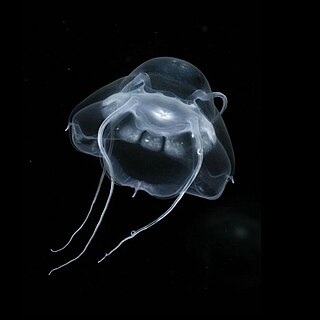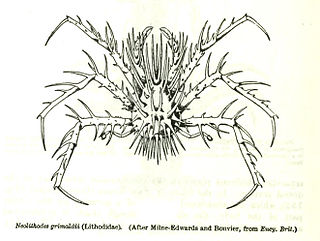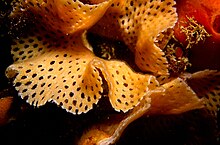
Lepidoteuthis grimaldii, also known as the Grimaldi scaled squid, is a large squid growing to 1 m in mantle length. It is named after the Grimaldi family, reigning house of Monaco. Prince Albert I of Monaco was an amateur teuthologist who pioneered the study of deep sea squids by collecting the 'precious regurgitations' of sperm whales. The Grimaldi scaled squid was first collected from the stomach contents of a sperm whale. It is a widely distributed species in tropical and subtropical areas of the North and South Atlantic, the southern Indian Ocean and the Pacific Ocean, where it has been recorded off Japan and in the west Pacific.

Archaeidae, also known as assassin spiders and pelican spiders, is a spider family with about ninety described species in five genera. It contains small spiders, ranging from 2 to 8 millimetres long, that prey exclusively on other spiders. They are unusual in that they have "necks", ranging from long and slender to short and fat. The name "pelican spider" refers to these elongated jaws and necks used to catch their prey. Living species of Archaeidae occur in South Africa, Madagascar and Australia, with the sister family Mecysmaucheniidae occurring in southern South America and New Zealand.

Mastigoteuthis grimaldii is a species of whip-lash squid.
David A. Grimaldi is an entomologist and Curator of Invertebrate Zoology at the American Museum of Natural History in New York. He received his graduate training at Cornell University, where he earned his doctorate in Entomology in 1986. Dr. Grimaldi is an authority in many fields of insect systematics, paleontology, and evolutionary biology.

Cylichna is a genus of sea snails or bubble snails, marine gastropod molluscs in the family Cylichnidae, the "chalice bubble snails".
Protortalotrypeta is a monotypic genus of tephritid or fruit flies in the family Tephritidae. It contains the species Protortalotrypeta grimaldii.

Narcomedusae is an order of hydrozoans in the subclass Trachylinae. Members of this order do not normally have a polyp stage. The medusa has a dome-shaped bell with thin sides. The tentacles are attached above the lobed margin of the bell with usually a gastric pouch above each. There are no bulbs on the tentacles and no radial canals. Narcomedusans are mostly inhabitants of the open sea and deep waters. They can be found in the Mediterranean in large numbers.

Calliostoma grimaldii is a species of sea snail, a marine gastropod mollusk in the family Calliostomatidae.

Dryinus grimaldii is an extinct species of wasp in the dryinid genus Dryinus. The species is solely known from the early Miocene, Burdigalian stage, Dominican amber deposits on the island of Hispaniola.

Dryinus rasnitsyni is an extinct species of wasp in the dryinid genus Dryinus. The species is solely known from the early Miocene, Burdigalian stage, Dominican amber deposits on the island of Hispaniola.

Neolithodes is a genus of king crabs, in the family Lithodidae. They are found in all major oceans, both in high and low latitudes. Although there are records from water as shallow as 124 m (407 ft) in cold regions, most records are much deeper, typically 700–2,000 m (2,300–6,600 ft), with the deepest confirmed at 5,238 m (17,185 ft). They are fairly large to large crabs that typically are reddish in color and spiny, although the size of these spines varies depending on species.
Aristostomias is a genus of barbeled dragonfishes native to the ocean depths in the Pacific, Atlantic and Indian oceans.

Reteporella is a genus of bryozoans in the family Phidoloporidae.

Neolithodes grimaldii, the porcupine crab, is a species of king crab in the family Lithodidae. This large red crab is found in cold deep waters in the North Atlantic and often caught as a bycatch in fisheries for Greenland turbot. As suggested by its common name, the carapace and legs are covered in long spines.

Antiopella cristata, sometimes known by the common name crested aeolis, is a species of nudibranch, a marine gastropod mollusc in the family Janolidae.
Plectromerus grimaldii is a species of beetle in the family Cerambycidae.

Monacoa is a genus of fish in the family Opisthoproctidae found in Atlantic and Pacific Ocean. They are also known as mirrorbellies, in reference to the bioluminescent organ in their intestines.
Burmesarchaea is a diverse extinct genus of spiders, placed in the family Archaeidae. The type species Burmesarchaea grimaldii was first described in 2003 and least 13 more species have been assigned to the genus. The genus has been exclusively found in Cretaceous Burmese amber, which is dated to 99 million years ago.

Opisthoteuthis grimaldii is an octopus found near the Azores.














